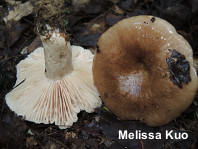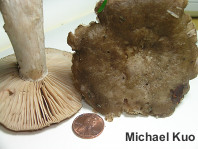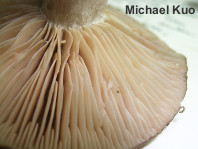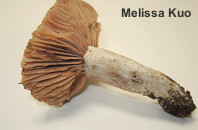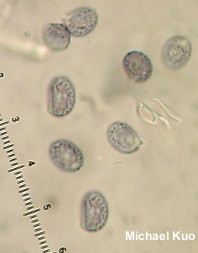| Major Groups > Gilled Mushrooms > Pale-Spored > Russula > Russula eccentrica |

|
Russula eccentrica [ Basidiomycota > Russulales > Russulaceae > Russula . . . ] by Michael Kuo This distinctive russula appears in late summer from the southern Appalachian Mountains to Missouri and the Gulf Coast. It features a brownish cap, distantly-spaced pink gills, and pinkish flesh in the stem. The "skin" on the cap surface is tightly affixed, and does not peel away easily—and, under the microscope, it features spores with very low ornamentation that sometimes forms faint reticulate patterns. On the West Coast the name "Russula eccentrica" has sometimes been applied to a similar, oak-associated species with pink-bruising surfaces and gills that are white before bruising; Arora and Nguyen named that species Russula cantharellicola in 2014. Thanks to Walt Sturgeon for teaching me this species. Description: Ecology: Mycorrhizal with various trees, including eastern hemlock, American beech, oaks, and hickories; growing alone, scattered, or gregariously; summer and early fall; southeastern North America from the southern Appalachians to the Gulf Coast. The illustrated and described collections are from Ohio. Cap: 5–8 cm; convex when young; becoming broadly convex, flat, or shallowly depressed; tacky to sticky when fresh; when young bald or nearly so, with a waxy feel when rubbed--becoming rougher and finely cracked to fibrillose; buff when young, maturing to pale brown; the margin not lined; the skin not peeling easily. Gills: Broadly attached to the stem; distant or nearly so, at least by maturity; thick; short-gills present; pale pink to brownish pink; spotting brownish with age. Stem: 5–8 cm long; 1–2 cm thick; slightly tapered to base; sometimes slightly off-center (hence the species name eccentrica); dry; bald; whitish; bruising pink and eventually brownish where handled (but according to Bills [1985] the stem surface does not actually bruise; instead, it erodes and exposes pink flesh beneath the surface); hollowing with age; basal mycelium white. Flesh: Whitish in cap, pinkish in stem; unchanging when sliced. Odor and Taste: Odor not distinctive; taste not distinctive, or slowly acrid. Chemical Reactions: KOH negative on cap surface. Iron salts negative or slightly pink on stem surface. Spore Print: Reported as white (Bills, 1985). Microscopic Features: Spores 6–9 x 5–6 µm; ellipsoid; ornamentation under 0.5 µm high, as isolated amyloid warts and occasional connecting lines that may form partially reticulated areas. Cheilocystidia 30–40 x 2.5–5 µm; cylindric to filiform or subaciculate; smooth; thin-walled; hyaline to golden in KOH. Pleurocystidia similar. Pileipellis poorly defined; cutis-like; golden brown in KOH; elements 2.5–5 µm wide, smooth. REFERENCES: Peck, 1911. (Burlingham, 1915; Saccardo, 1925; Bills, 1985; Weber & Smith, 1985 ["subnigricans"]; Kibby & Fatto, 1990; Roody, 2003; Binion et al., 2008.) Herb. Kuo 07181501, 07191508. This site contains no information about the edibility or toxicity of mushrooms. |
© MushroomExpert.Com |
|
Cite this page as: Kuo, M. (2017, May). Russula eccentrica. Retrieved from the MushroomExpert.Com Web site: http://www.mushroomexpert.com/russula_eccentrica.html |
